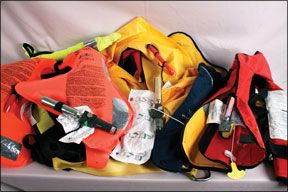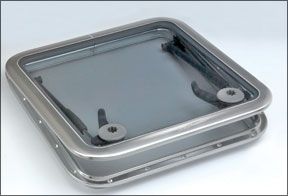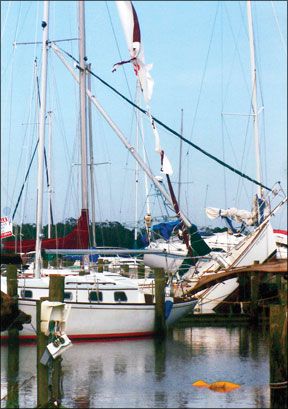Re-Arming A PFD
In your June 2008 article “Comparing the Latest Inflatable PFDs,” you mention at the beginning of the article that Personal Flotation Devices (PFDs) should be cleaned and stored as directed by manufacturers and that inflation mechanisms should be routinely inspected.
In the case of inflatable PFDs that meet Safety of Life at Sea (SOLAS) standards, such as the Viking products you reviewed, it is a SOLAS requirement that they be inspected and tested in the premises of an approved service station every 12 months. In all other cases, this is highly recommended for an item of lifesaving equipment. Your article goes on to say that re-arming and re-packing a PFD generally is easily carried out. I suggest that this information is dangerously misleading. A manufacturers manual for a PFD can run into more than 100 pages covering the unpacking, cleaning, inspection, testing, repair, and assembly.

288
Hopefully, you will be able to enlighten your readers to the risks they take by not having a PFD professionally inspected once it has been used.
K. C. Johnson
Consultant to SurviviTEC Group
Buenos Aires, Argentina
The importance of careful repacking, maintenance, and routine inspection of inflatable PFDs cannot be overstated. However, all of the manufacturers of the PFDs we tested say that routine inspection and re-packing of these products can be safely carried out by owners, so long as they follow the directions and use approved re-arming kits. Buyers are strongly urged to carefully read and keep the owners manual for these and other lifesaving products. Self-inspection would invalidate a SOLAS rating, but this rating is not required for PFDs on recreational boats. Mustang, maker of our Best Choice combination PFD/harness, the MD3184,
has video demonstrations of re-packing its vests online at
If there is even the slightest doubt about the condition of the life vest or how to re-arm or repack it, take the device to a certified service center for inspection and re-packing.
A PFD that has been inflated in the water may require special care prior to re-packing and re-arming. Cylinder corrosion and air leaks are common problems. Mustang recommends orally inflating its PFDs and leaving them overnight to check for leaks. It is also important to register your PFD with the manufacturer, so that you may be contacted regarding safety alerts (see page 5). Finally,
Practical Sailor recommends that sailors also carry conventional Type I or Type II PFDs on board their boats for use when crew has time to don a traditional life jacket in an emergency.First-Aid Feedback
Interesting that you would have an article on first-aid kits just after I finished updating the first-aid kits that I carry on my boat and in my duffel bag!
Part of what prompted me to update the kits was that some of the supplies had gone stale or had been used up. Each kit fits into its own waterproof box that I got from a new company called Getstorganized (www.getstorganized.com). The company makes and imports plastic boxes designed for boat use. I also got some small Ziplock bags and put things in the bags.
By your standards, I would get dinged for no instruction book and things being put in a bit jumbled.
One feature that I am proud of is that I put the following items in a 3-by-4-inch Ziplock bag that can be handed out if someone scrapes their finger and just needs real basic treatment. I have two or three of each of these in each kit:
Small Ouch Band-Aid Pack
1 alcohol gel hand wipes
1 benzalkonium chloride
antiseptic towelette
1 providone-iodine USP prep pad
1 triple antibiotic ointment
1 1- x 3-inch flexible fabric
adhesive bandage
1 3/4- x 3-inch flexible fabric
adhesive bandage
1 5/8- x 3-inch flexible fabric
adhesive bandage
Mike Brough
J/92
Seattle, Wash.
The Getstorganized products, which allow for mounting in various unused spaces, look interesting enough for us to order a few for our mid-sized test boat, the Catalina 22. Well report any additional findings in an upcoming issue. Thanks for the idea.
The 100-Percent Hat
Your hat test (June 2008) ignored the most important reason to wear a hat: protection. The Izeo hat folds small in seconds, offers 100 percent protection, and is 100 percent nerd-approved. It is very practical, reasonably priced, and has a chin strap. Smaller models are better for windy conditions. You can find them at www.izeo2.com.
Rodney Farnsworth III
West Tech Windcraft
Nantucket, Mass.
We received a number of readers recommending full-brim hats over baseball-type caps. The Izeo looks like a welcome entry into the hat category, which probably deserves a second look before next summer. The Tilley Hat (www.tilley.com)-one of our favorites in past testing (June 15, 1994)-received many favorable letters as well.
Two-Way Opening Hatch?
I remember reading about a deck hatch that opens both fore and aft. Im in the

288
market, but I can’t find this feature. Am I imagining this?
Pete Ensinger
Via e-mail
Goiot (www.goiot.com) recently announced a new line of custom two-way hatches. We have not tested the product, but are working on a hatches and ports report. These hatches are becoming more popular in the wake of new European Union (CE) safety standards for hatches, which favor aft-opening hatches. Hatches that face aft offer lousy ventilation at anchor, but an open aft-facing hatch is less likely to be torn from its hinges by a breaking wave. Suffice it to say that hatches -whichever direction they open-should be shut in conditions when a hatch could be torn from its hinges.
Cockpit Reefing
Did you run a series of articles on simple solutions to make sailing by seniors safer? If you did, Im trying to find an article on a reefing system using blocks that lead back to the cockpit.
David W. Baker
Hunter 30T
Fernandina Beach, Fla.
We are working on an article on running-rigging upgrades along the lines that you describe, and you can find the article “Reefing Tips from the Pros,” online in the “Tools and Techniques” section at
www.practical-sailor.com. The relatively fit delivery skippers in that article generally favor conventional slab-reefing with lines led to the mast. It was preferred for its simplicity and reliability. Although we have no specific tests of complete system for running reefing lines back to the cockpit, we have evaluated many of the necessary components including blocks (“Block Efficiency,” June 2002) and rope clutches (“Clutch Play,” April 2006). Every boat is a little different, and a local rigger or major manufacturer should be able to guide you through the process. Keep in mind, these systems do add friction into the system. One thing that we highly recommend is a small block at the reefing clew for the reefing lines to pass. This is very helpful in alleviating friction at the clew, even if you are not leading the reefing lines back to the cockpit.Tough Island Packet 26
I suggest you look at the Island Packet 26 for your Tough Boat list. I bought an IP 26 just after it was damaged in Hurricane Katrina at Mobile Bay, Ala. (See photo

288
above; it is the boat pushed up vertically onto the dock, with a piling rudely impaling its hull in the area of where the head was.) I bought it on the Internet after it was salvaged, took it to Kemah, Texas, had a yard repair the hull, and then got it back in the water sailing again. Even though it was sitting on its stern and rudder, it came through the ordeal relatively unscathed as far as the fiberglass hull was concerned. Sure, I had to replace some stanchions, lifelines, etc., but the tough old fiberglass hull was basically intact, other than that one hole.
Kyle Stallones
Island Packet 26
Kemah, Texas
Tank Critters
Regarding your advice in the June issues Mailport that, “Weve yet to meet a plumbing hose-clear or opaque-that can keep a menagerie of creatures from flourishing in our water tanks.” I have found consistently in the 27 years I have owned my Mariner 47, that her four stainless-steel water tanks have remained fresh smelling and clean by the simple expedient of adding a quart of Clorox bleach to each of the four tanks in the fall and filling the tanks with water to coat the entire interior with bleach prior to emptying them for the winter. The diluted bleach solution is then run through the hoses to the sinks/shower to allow the bleach to coat the inner walls of the hoses. This run through is for about 10 minutes. The tanks are then emptied into the bilge and pumped overboard, and the hoses drained at their lowest point and the sink faucets all opened to allow drainage. The hot water tank is similarly drained from its own petcock.
When we refill the tanks in the spring, the water smells fresh and, although we use a water filter for drinking water, we have no sense of bad smelling or tasting water ever.
Bob Gould,
Free Spirit, Mariner 47
Wellesley, Mass.
Chlorine bleach has long been a solution for cleaning hoses or purifying water. However, Clorox, even diluted, should not be dumped into the water if it can be avoided. We suggest pumping the solution into a sealed container rather than your local waterway.
BoatHistoryReport.com
I am buying a used sailboat, and am curious about a company called BoatHistoryReport.com. What do you know about them? It costs $44 to get a report on a boat. They check accident insurance reports, etc.
John Chandonnet
Via e-mail
The paper trail, if any, left by damaged and repaired boats is much harder to follow than the one for insured cars. Except perhaps in the high-end yacht market, where LLoyds Certification is the norm, the likelihood of getting a complete report is not great. We recommend saving your money for a proper survey-and will take this opportunity to shamelessly promote our own used boat reports and “Used Boat Guide,” available on the website
www.practical-sailor.com. Since a survey is expensive, it is a good idea to rule out potential lemons first. You can also find some good information on trouble spots from the owners of sisterships. We have links to many of owners association websites at www.practical-sailor.com, as does Good Old Boat at www.goodoldboat.com.Collinite Wax
I recall years ago you did an article on boat polish and gave one of Collinites products a good rating. Do you plan on doing another un-biased and valuable review and article on boat polishes to use in our area? (ease of use, gloss, durability, etc).
Brian Parent
28 ODay
Fairfield, Conn.
Indeed, Collinite 885 was the Best Choice in our last test of waxes and polishes, which we wrapped up in the Nov. 15, 2005 issue. Given the staggering amount of new products in this category, there have either been some new developments or the marketeers are hard at work. In either case, we are rounding up another truckload of waxes to test, starting with paste waxes, which generally fared best in the last go round. Thanks to all the readers who suggested their favorites. Add yours to the list-send e-mail to practicalsailor@belvoirpubs.com.
Winch Buddy
I was wondering whether you have any experience with the WinchBuddy, which allows you to “turn your winches into power winches with a portable … variable speed unit and socket driver.” As I get older, raising the main gets a little harder.
Barry Sachs
Tartan 40
Noank, Conn.
We have the WinchBuddy and will soon report on it. In February 1996,
Practical Sailor reviewed similar products, including, the Easywinch (http://www.easywinch.com/), which is still around.

































